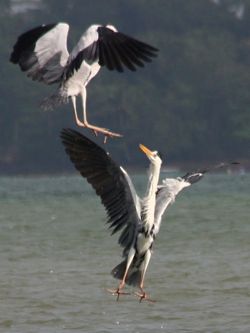“Regarding the post of the Grey Herons, I am no expert but these images showing both breeding (left) and non-breeding (below) plumage of the Grey Herons (Ardea cinerea) will, hopefully, help answer the question of whether the dark down feathers of Grey Herons only appear during nesting and breeding periods.
“The dark feathers mentioned are located along the flanks below the wings of the herons. Thus, they are not very obvious when the wings are folded. The dark feather s below the ‘armpits’ will only become prominent when the wings are unfolded and there is sufficient light reaching the normally shaded area.
“Attached is an image of two Grey Herons that had been posted earlier during a brief confrontation (above left). The image of the lower heron clearly captured the complete pattern of the dark down feathers below its body. As seen, the pattern of the dark feathers forms a complete loop starting from the breast below the neck, which is normally covered up by the long ornamental white breast feathers. It then continued along both flanks below the wings to unite each other near the rear bottom of the bird. The dark down feathers end just before the vent.
“The dark feathers could also be seen in the other pictures showing a non-breeding heron in water (above right), a full breeding plumage heron with its wings out-stretched, and another full breeding plumage heron on a tree.
“As seen from the attached pictures, it does seem evident that the dark feathers of Grey Herons do appear during both non-breeding and breeding periods.”
Kwong Wai Chong
Singapore
5th October 2010












One Response
Hi Wai Chong
Thanks for answering my question on the dark down feathers. It was interesting to note that the feathers form a complete loopping pattern below the wings and around the neck and belly. Have not noticed this before. Your pictures and explanation were very helpful.
Thanks and regards
Chow Ngian